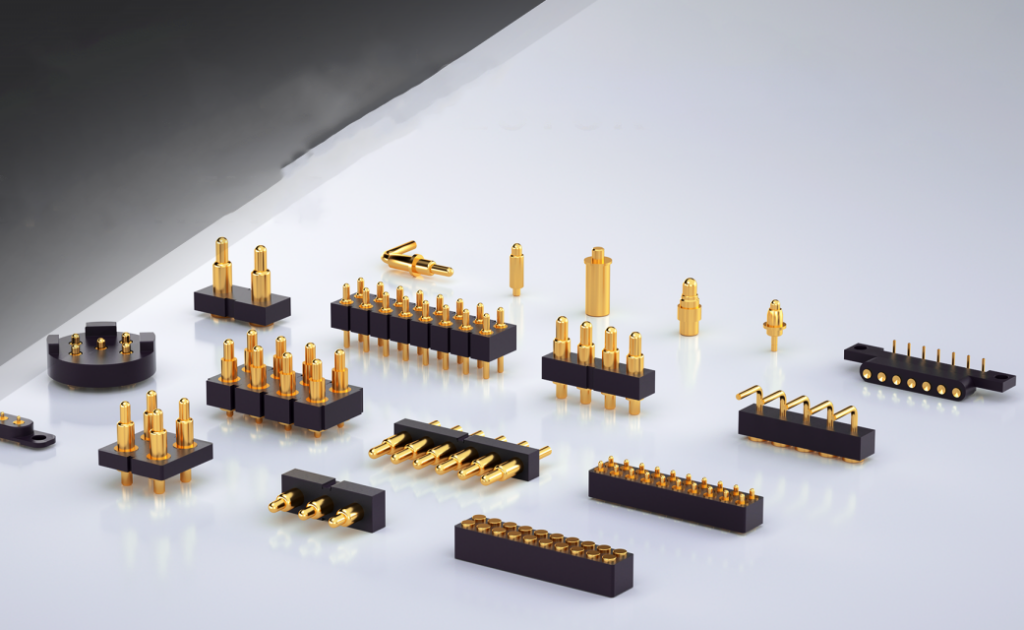Surface Mount Technology (SMT) pogo pins are essential components in modern electronic devices, providing reliable electrical connections in compact designs. Whether used in consumer electronics, automotive systems, or medical devices, these spring-loaded pins must meet specific performance criteria to ensure they function optimally in various applications. Here are the key factors to consider when choosing SMT pogo pins.
Application Requirements
The first consideration when choosing SMT pogo pins is the specific requirements of your application. Pogo pins are widely used in various industries, including consumer electronics, automotive, and medical devices. Each industry and application has unique demands, from data transmission to power supply. You need to define the primary function of the pogo pin within your product, such as:
- Power transmission: For high-current applications like battery charging systems.
- Data transfer: Used in mobile devices or wearable technology for seamless communication.
- Testing environments: Pogo pins can be used as part of test fixtures to establish temporary connections during the testing phase.
By clearly identifying the purpose of the pogo pin, you can choose one with the appropriate specifications, such as contact resistance, current capacity, and material composition.
Size and Spacing
Space is often a critical factor in modern electronics, and SMT pogo pins must fit within the spatial constraints of the printed circuit board (PCB). As devices become smaller and more complex, the size and spacing of the pogo pins play a crucial role in ensuring the overall functionality of the device.
- Pin diameter: Depending on the application, pogo pins come in various diameters, ranging from ultra-fine to larger sizes for higher current capacities.
- Height: The height of the pogo pin must match the clearance between the components on the PCB and the housing of the device.
- Pin-to-pin spacing: This refers to the distance between adjacent pins, which is essential for preventing electrical interference and ensuring a stable connection.
A pin that is too large or spaced too closely to others can cause signal interference or result in mechanical failure due to inadequate soldering.
Electrical Performance
Another critical factor in selecting SMT pogo pins is their electrical performance, which includes current capacity, voltage rating, and contact resistance. These characteristics directly influence the reliability and efficiency of the connection.

- Current rating: Pogo pins designed for power applications must handle high current without overheating. Ensure the chosen pogo pin has a sufficient current rating for your application.
- Contact resistance: Low contact resistance is crucial for maintaining efficient electrical connections. High resistance can lead to energy loss, increased heat, and decreased device performance.
- Signal integrity: For data transmission applications, it is essential to choose pogo pins that maintain signal integrity, with minimal electrical noise or signal degradation.
Mechanical Durability
Mechanical durability is another important factor to consider, particularly in applications where the pogo pin will undergo repeated compressions and decompressions. For example, pogo pins used in battery charging systems or testing environments may need to endure thousands of cycles without losing their spring force or electrical performance.
- Spring force: The spring inside the pogo pin determines the pin’s ability to maintain contact pressure. Too much spring force can damage the PCB, while too little may result in a weak connection. The ideal spring force depends on the specific application and mechanical environment.
- Plating material: Pogo pins are often plated with gold, nickel, or other materials to enhance their conductivity and resistance to corrosion. Gold plating is common due to its excellent conductivity and resistance to wear, ensuring the pin’s longevity.
- Life cycle: Check the expected life cycle of the pogo pin, especially if it will be used in high-frequency applications. Some pogo pins are rated for millions of cycles, making them suitable for long-term use..
Soldering Method and PCB Mounting
The method of mounting the pogo pin onto the PCB is another factor that should not be overlooked. SMT pogo pins are typically soldered onto the PCB using surface mount technology, which offers several advantages but also comes with certain limitations.
- SMT mounting: This method allows pogo pins to be soldered directly onto the PCB without the need for through-holes, saving space and simplifying the assembly process. However, the flat-bottom design of SMT pogo pins means they have less soldering strength compared to through-hole versions.
- Double-sided mounting: Some SMT pogo pins can be mounted on both sides of the PCB, further reducing space requirements and enhancing the overall design flexibility.
- Soldering strength: Since SMT pogo pins rely on the strength of the solder joint, it’s important to ensure that the flat-bottom design will hold up under the mechanical stresses of the application.
Environmental Factors
Environmental conditions can significantly impact the performance and longevity of SMT pogo pins. If the device will be exposed to harsh conditions, such as extreme temperatures, humidity, or vibration, it is essential to choose pogo pins that are designed to withstand these challenges.

- Temperature range: Ensure that the pogo pin can operate within the temperature range of the application. Some pins are designed to perform in extreme temperatures, making them suitable for automotive or aerospace applications.
- Corrosion resistance: Pogo pins exposed to moisture or corrosive environments should be plated with materials like gold or nickel to prevent oxidation and ensure reliable performance.
- Vibration and shock: In high-vibration environments, such as in automotive or industrial applications, pogo pins must be able to maintain a stable connection without becoming dislodged.
Cost Considerations
While it’s important to choose pogo pins that meet the technical and environmental requirements of your application, cost is always a factor to consider. SMT pogo pins can vary in price depending on factors like material, plating, and life cycle ratings.
- Standard vs. custom designs: If your application requires a high level of customization, such as specific pin lengths or spring forces, this can increase the overall cost of the pogo pin. However, many manufacturers offer standard designs that can meet the needs of most applications at a lower cost.
- Volume requirements: The cost per unit often decreases with larger production volumes. If you’re working with small quantities, consider whether a standard pogo pin can meet your needs before opting for a custom solution
Conclusion
Choosing the right SMT pogo pin involves balancing various factors, including application requirements, size, electrical performance, mechanical durability, and environmental conditions. By carefully considering each of these aspects, you can select a pogo pin that not only meets the technical demands of your project but also ensures long-term reliability and cost-effectiveness. Whether you’re designing consumer electronics or industrial machinery, the right pogo pin will play a crucial role in the overall success of your product.



